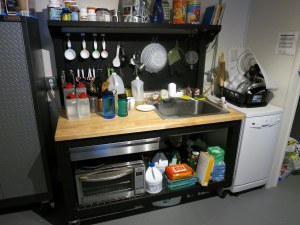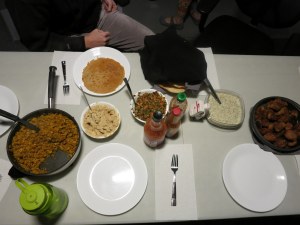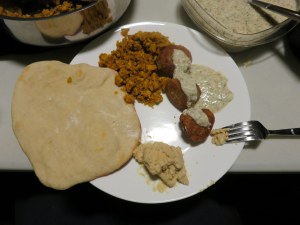I worried a bit about the food that we would have here on Mars in the lead up to the mission. The food at MDRS (where I did my previous Mars mission) left something to be desired and the first mission at this habitat was a study looking at the palatability of food for Mars missions, so it can be an issue. The first week we were all a little tentative learning to cook with the ingredients we have here. Gallon jugs of freeze dried vegetables, big cans of freeze dried meat and then things like pasta, sugar, rice, flour and other grains make up the basis of most of our meals. Our ability to cook with the stuff we have has vastly improved over the past few weeks. I am unquestionably eating better here than I did living on my own.
The cooking schedule we decided on is each dinner has a chef, sous chef and a couple people on clean up. We have leftovers for dinner whenever we need to clear out our mini fridge for the next round of meals, which has been about one a week. This means on average each person is in charge of cooking only one meal a week and helping with another. Since each person doesn’t cook very often we’ve gotten into a bit of a thing doing pretty elaborate (and delicious) meals.
Our kitchen isn’t anything fancy but generally has worked quite well. We mostly cook on a couple induction hotplates and an oversized toaster oven, though we also have a bread maker, rice cooker, microwave, electric kettle, electric griddle, electric wok and a pop up toaster. The biggest problem is that they undersized the wiring/breakers and you pop a circuit breaker if you use more than two of those at any one time.
For breakfast and lunch people do whatever they are feeling. At least once a week someone has been motivated to make a big breakfast. People will also do dessert whenever they feel inspired; we’ve had cookies, brownies, bread pudding and even handmade sherbet and vanilla ice-cream. Our commander, Martha, has been really good about making bread and yogurt a few times a week so we usually have some of that around well.
Typically I’ve been eating cereal with powdered milk for breakfast. Lunch is usually leftovers, peanut butter on a tortilla and dried fruit and nuts, boxed mac and cheese, or just a clif bar. The process for making a real meal from dehydrated ingredients usually starts with rehydrating everything. This takes a couple hours if you just pour hot water over it and let it sit, less if you simmer it. We generally try to go with the former due to energy concerns. We get our power from solar cells and batteries that they charge during the day. Since cooking dinner is the most energy intensive thing we do we try to limit our power use and shift everything we can from night time to the afternoon when we have fully charged the batteries and have excess power generation capacity.
The vegetables, fruit and meat turn out fairly well if a bit lacking in texture. The cheese is alright, we’ve had some pretty good pizza and I managed a solid quesadilla as well, but you aren’t going to be putting it on crackers. Butter comes in the form of anhydrous (without water) butter fat, it’s a bit strange but seems to do all the right things. Most of the other dairy (powdered milk in particular) is pretty bad. We have egg crystals for eggs and they make really good scrambled eggs and work fine in baked goods but don’t work as well as a binder as real eggs.
 Clockwise from top right mixed vegetables, payapa, beef cubes, chedder cheese.
Clockwise from top right mixed vegetables, payapa, beef cubes, chedder cheese.
In terms of what we’ve made while we’ve been here, we’ve done Indian, Thai, Persian, Ghanaian, Chinese, Hawaiian, Greek/Turkish, Russian/Azerbaijani a few times, Mexican a couple times, a few Italianish dishes plus some more American stuff included some solid southern and general comfort food.
We’ve already run out of a few critical ingredients that are limiting our options for the time being, tomato paste and chicken stock being the most critical, but otherwise we have a pretty massive pantry. We get our first resupply mid next month and have already given them a large list of the items we would like.
Last night I made a Greek/Turkish spread. Turkey Shawarma (though not on a spit or grill unfortunately), falafel, hummus, yogurt sauce and homemade pita
Other meals I’ve made so far:
Pasta with lemon and chicken
Red beans and rice
Chicken fried rice
Plus one big eggs, hashbrowns and bacon breakfast
I’m plotting a few more elaborate meals but I’m waiting on some unusual ingredients in the next resupply before I can make them. I’m making stuff here that I would never attempt to make a home just because we don’t have the option to go buy things.







Looks as god as Felafel King! ;))
FYI, chia seeds make a really good binding ingredient (when water is added), and are a good source of nutrition as well…and probably better for you than the powdered milk!
Really enjoying your blog!
LikeLike
Thanks for the tip, it turns out we even have some. I’ll have to give them a try.
LikeLike
This looks like so much fun. Good on you for the cooking. You should turn this into a cookbook. You never know. Also what is the best way to contact you again? Via email?
LikeLike
We’ve been recording some meals and recipes but a lot of this stuff wouldn’t be all that useful on the outside world since no one has these fairly bizarre ingredients.
Email is pretty much your only option.
LikeLike
[…] I worried a bit about the food that we would have here on Mars in the lead up to the mission. The food at MDRS (where I did my previous Mars mission) left something to be desired and the first mission at this habitat was a study looking at the palatability of food for Mars missions, so it can be an issue. The first week we were all a little tentative learning to cook with the ingredients we have here….(more) […]
LikeLike
Loved this post! I hope you don’t mind, but I shared it on my Facebook page with the following content. I thought it was a great platform to use to share some simple energy efficiency tips for cooking in any environment. I recognise that you may have limited resources there at the Hi-SEAS complex, but hopefully some of these may be helpful or of interest to you also.
“Food for Thought:
I’m a bit of a foodie and sustainability nut, so I found this to be an interesting blog post on the food eaten by the current simulated astronauts in the Hi-SEAS Mars analogue.
It had me thinking about energy efficient cooking techniques. Cooking our food actually contributes about 25% of our food’s ecological footprint. Rehydrating food overnight/hours beforehand is an important step that the simulated astronauts take to conserve their energy. The energy produced at the Hi-SEAS location is through solar power.
Some other simple cooking techniques that could also be applied in the simulation to help conserve energy could include:
– using pressure cookers (they use 40% less energy than regular pots)
– using pots/pans with flat bases that match the shape & size of the heating element (reduces unnecessary heat loss and excess heat production)
– keeping the lid on pots when cooking and try to avoid ‘peeking in’ – this includes when baking (don’t open the electric oven door). Cooking without lids uses three times as much energy
– consider single-pot meals
– cook in bulk & freeze extras. It takes far less energy to reheat a meal than to cook another one from scratch.
– when using a toaster oven, ensure to cook multiple things at once to maximise the heat use
– if using any devices to defrost or reheat, use a microwave over the stovetop or electric toaster (stovetops and the toaster oven take longer to heat up to an effective temperature). Better yet, thaw frozen food in the fridge overnight or during the day instead.
– don’t pre-heat the toaster oven when baking. It doesn’t really make much difference.
– making a cup of tea? There have been plenty of energy efficiency studies that show heating the exact amount of desired water for 1 cup in an electric kettle that turns off automatically when the correct boiling temperature is reached is more energy efficient than (2nd place) microwaves and (third) using the stovetop
– use a toaster to toast bread, and not the grill on the electric oven (uses 1/3 of the amount of energy)
– eat more raw foods
– chose recipes with very short cooking times
– clean clean clean those metal or convection plates that are under or above the heating elements that the pots sit on. In the regular kitchen, the metal below the heating element also plays a role in reflecting heat, so a dirty stovetop needs to work harder. Also clean the microwave. Microwave ovens work more efficiently when clean because any spills or food scraps in the microwave will also be absorbing energy waves as easily as the food that is being cooked.
Some simple tips that may be as useful at home as on Mars : )”
Cheers
Dianne
LikeLike